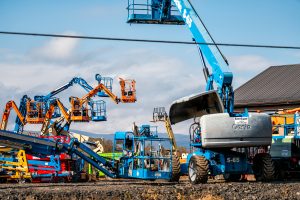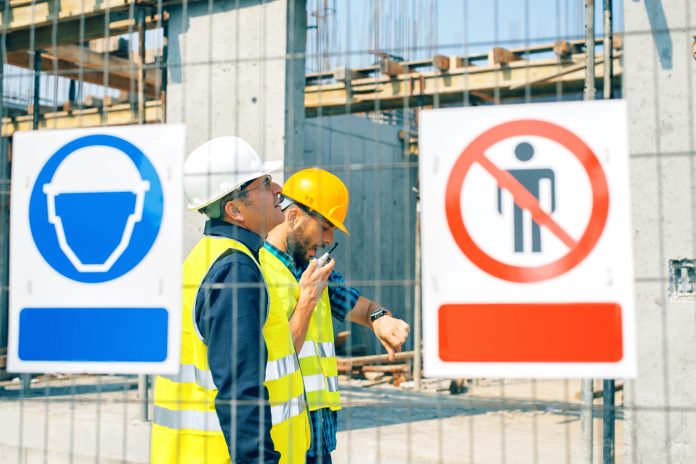Sufficient construction site health and safety standards are paramount due to the countless hazards, from falls to electrocution to exposure to dangerous chemicals
To carry out satisfactory construction site health and safety standards, to start with, you must conduct regular safety inspections is critical. You need to identify any potential hazards and take steps to mitigate them before they cause harm.
Additionally, providing adequate training for workers is crucial – not only initial training but ongoing education as well.
Proper equipment maintenance is also vital. If tools or machinery aren’t functioning correctly, accidents can happen.
Implementing effective communication channels is key, too; everyone needs to be on the same page when it comes to safety policies and procedures.
Identifying hazards and enforcing safety policies are also necessary components of maintaining a healthy and safe worksite culture – one where everyone understands their role in keeping themselves and others safe.
Key health and safety standards
- Prioritizing safety over speed and cost-cutting measures is crucial in construction.
- Regular safety inspections, adequate training for workers, and effective communication channels are necessary for maintaining a safe worksite.
- Identifying and addressing hazards through risk assessment techniques and effective risk management practices is essential.
- Strong safety leadership skills, a reporting system for near-misses and incidents, emergency response planning, and employee engagement through safety incentive programs are also important for achieving healthy and safe construction sites.
Conducting regular safety inspections
To ensure that your construction site is always safe and secure, make sure to conduct regular safety inspections to identify potential hazards and control risks before they become major problems.
The frequency of inspections will depend on the size and complexity of your construction project. However, it’s recommended that you conduct daily inspections for smaller projects and weekly or monthly for larger ones.
Inspections should be conducted by a competent person who is knowledgeable about health and safety in construction.
During an inspection, use an inspection checklist to ensure that all areas of concern are covered.
Common inspection findings include inadequate signage, unsafe working conditions, poor housekeeping, electrical hazards, lack of personal protective equipment (PPE), and missing or damaged safety equipment.
After conducting the inspection, create an inspection report outlining any issues found and steps taken to address them.
This report serves as documentation of compliance with health and safety regulations and can also help prevent future incidents on your construction site.
Providing health and safety training for workers
Ensuring workers receive proper training is crucial for maintaining a secure work environment on the job. Effective training techniques can help to prevent accidents and increase productivity.
To meet OSHA standards, construction companies should provide mandatory safety certifications for their employees.
Worker engagement is also an essential component of providing adequate training. It’s important to make sure that workers are engaged in the process and understand why certain safety protocols are in place. This helps them recognize potential hazards and take appropriate action when necessary.
By investing time and resources into worker training, employers can create a culture of safety on construction sites. Workers who feel confident in their abilities to recognize and respond to potential hazards are more likely to report unsafe conditions or behaviours, which leads to a safer workplace overall.
Ensuring proper equipment maintenance
Just like a car needs regular maintenance to prevent breakdowns, construction equipment also requires routine upkeep to prevent accidents and ensure optimal performance. Equipment reliability is crucial in maintaining safe construction sites.
You need to assess the condition of your equipment regularly to identify any potential problems and address them before they become safety hazards.

To achieve this, you should establish a maintenance schedule that includes routine inspections and repairs.
Regular checks help you detect faults or wear and tear on your equipment before they cause accidents or disrupt work progress.
Additionally, conducting safety audits can help identify areas where improvements are needed in terms of equipment safety.
Ensuring proper maintenance of your construction equipment involves more than just fixing damaged parts; it also requires training employees on how to properly operate machinery and use safety equipment.
Implementing effective communication channels
Effective communication channels are crucial in maintaining a collaborative and informed construction team.
Communication strategies should be established at the beginning of any project, ensuring that all team members are aware of their roles and responsibilities.
Team collaboration is essential for successful communication. A table outlining each team member’s role in safety protocols and risk management can be useful for keeping everyone informed.
For instance, the site supervisor should communicate with workers about potential risks, while workers need to report any hazards they come across immediately. By working together as an effective team, everyone can contribute to building a culture of safety.
An example can be found below:
| Role | Responsibility |
| Site Supervisor | Communicate potential hazards and establish safety protocols |
| Workers | Report hazards immediately |
| Health & Safety Officer | Monitor compliance with regulations and identify areas for improvement |
| Project Manager | Ensure resources are available for health & safety initiatives |
A strong safety culture will help reduce accidents on the worksite. This means establishing rules and guidelines that prioritize safety over speed or cost-cutting measures.
Safety protocols should be enforced consistently throughout a project; otherwise, they become ineffective and ignored by workers who may feel pressured to complete tasks at any cost.
Effective communication channels play a significant role in creating a safe work environment where everyone feels comfortable reporting concerns without fear of retaliation or reprimand.
Identifying and mitigating hazards
You can’t afford to ignore the potential dangers lurking on a construction site – identifying and addressing hazards is crucial for keeping yourself and your colleagues out of harm’s way.
One important step in this process is using risk assessment techniques to identify potential hazards and evaluate their likelihood and severity.
Once you’ve identified these risks, it’s important to take steps to mitigate them by implementing appropriate safety measures such as personal protective equipment.
Strong safety leadership skills are critical for establishing a culture of safety on the construction site. Leaders must set an example by following safety protocols themselves and enforcing them among their team members.
Enforcing safety policies and procedures
Enforcing safety policies and procedures requires consistent adherence to established guidelines and a commitment to promoting a culture of safety among all workers on the job site.
This means that everyone involved in construction work, from managers to labourers, must be aware of the potential hazards and risks associated with their tasks, take steps to mitigate those risks and follow established protocols for reporting incidents or near-misses.
Promoting a culture of safety
Now that we have covered the importance of enforcing safety policies and procedures, let’s shift our focus to promoting a culture of safety. This involves creating an environment where everyone on the construction site feels responsible for ensuring that it remains safe.
As someone involved in construction work, it is important to understand that promoting a culture of safety is not solely the responsibility of management or safety professionals but rather requires everyone’s active participation.
One way to promote a culture of safety is through leadership responsibility.
It starts with managers and supervisors setting an example by adhering to all safety rules and regulations themselves while also holding their team members accountable for doing the same.
Additionally, conducting regular safety training sessions can help increase awareness among employees and encourage them to take ownership of their own personal safety as well as that of their colleagues.
Furthermore, conducting periodic assessments to gauge the current state of your organization’s safety culture can provide insight into areas that need improvement.
Employee engagement can play a crucial role in achieving this task by involving workers in discussions and decision-making processes related to workplace health and safety.
Safety incentive programs could also be implemented as an effective tool for motivating workers to prioritize safe practices on-site, while incident investigation techniques could help identify any potential hazards before they escalate into serious accidents or injuries.














